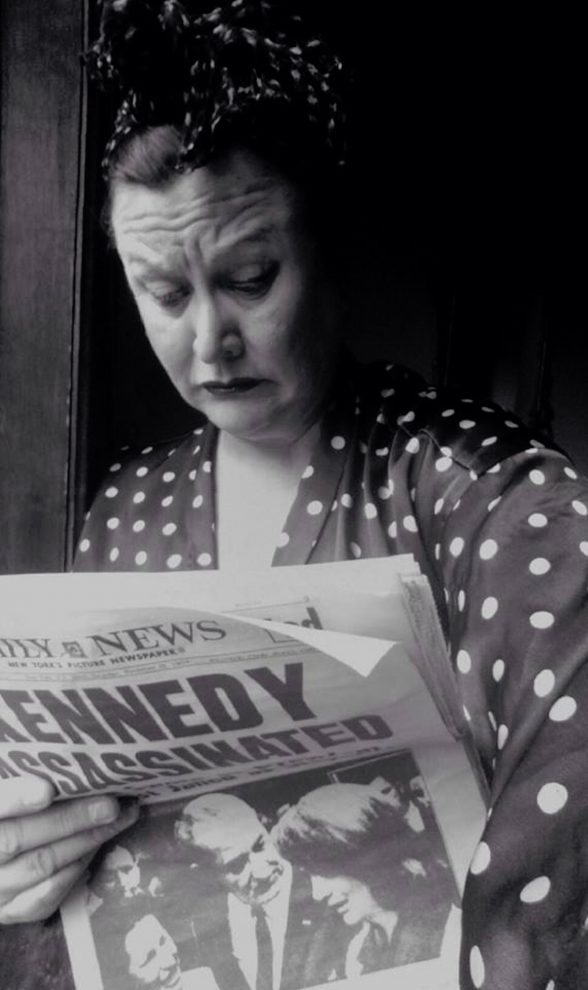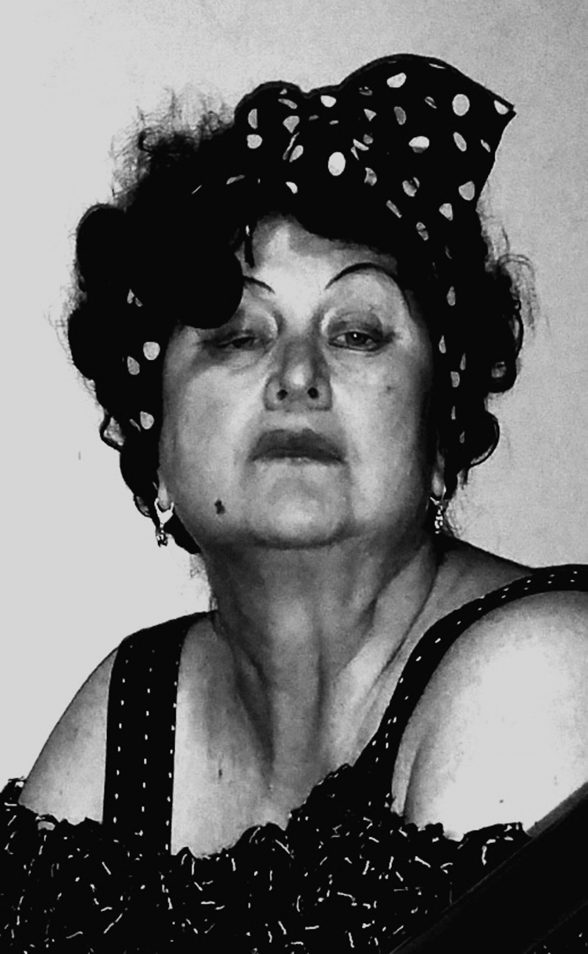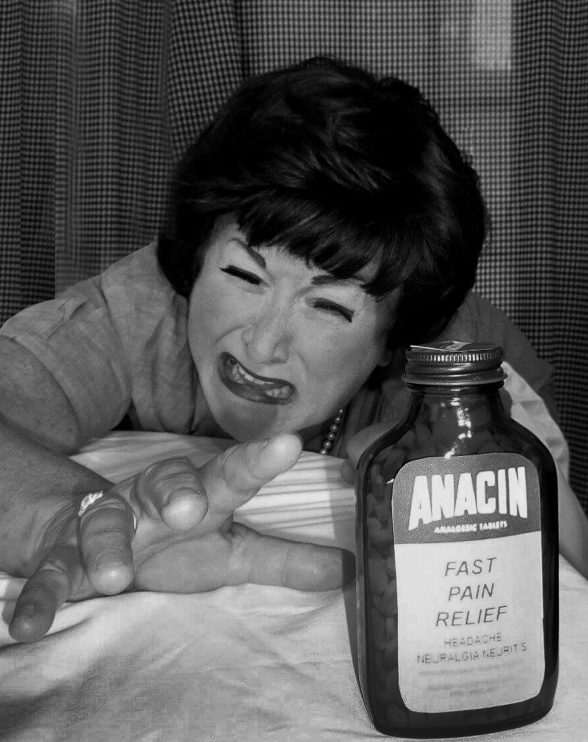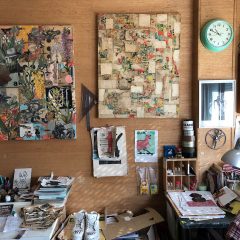When I made a studio visit to friend and artist Louise Millmann this summer at the Jersey Shore, she showed me an unusual “vintage” photograph: A 1960s housewife reading the Saturday November 23, 1963 Daily News front page – “ KENNEDY ASSASSINATED.” The woman in the photo was, in fact, Louise Millmann.

An artist and photography teacher from Long Island, NY, Louise Millman and I met in 2009 when I launched the project A Book About Death at the Emily Harvey Foundation Gallery in New York City. That show invited artists over the world to submit 500 “pages” in the form of postcards on the subject of death. Louise made herself invaluable with logistics in putting together the exhibition, and then a year later curated and staged a spinoff show at the RNG Gallery : A Book About Death Omaha.
Millmann’s current art making, she explained, puts herself more and more on camera. Along with friends, she performs roles – typically a working woman, but from different times and places. It could be a suburban housewife or a mid-century farmer, a migrant worker, a Parisian prostitute, a mourner from the 19th century.
The photographs portray worlds in which women are unconscious about themselves, yet consciously hammering out their roles. That they are staged offers another, more contemporary layer to their meaning.

While Millmann has had many exhibitions of her collage on paper works throughout the years, most recently at The Ripe Gallery on Long Island, the photo-works permit her to recast history with a nod and a wink.
“I typically arrange a photoshoot based on a guest’s visit, an odd acquisition, or a fortuitous happenstance,” Millmann explained. A year ago, she found a valise in a local historical society tag sale, “and out tumbled a big ball of moldy black fabric,” she said. “It was an amazing dress. After days of washing I discovered a complete and gorgeous 1860s mourning outfit.” That dress starred in a series of funeral marches Millmann created over the last two years.
In June, 2017, Millmann, who works with collaborators, assembled a troupe for a trip to Rockland, Maine to visit the Farnsworth Art Museum’s collection of Andrew Wyeth paintings.
The Farnsworth is steeped in early and mid-century art. Fairfield Porter, Berenice Abbott and many Andrew Wyeth paintings, particularly those he produced in Maine, fill the museum. Wyeth maintained a studio and home in nearby Cushing, where Alvaro and Christina Olson lived. Christina’s World, a 1948 Wyeth painting of Olson in a field just below her house, is one of the Museum of Modern Art’s most prized works.
Millmann found the Olson house largely intact, but also found a Maine that radiated Wyeth’s dry, sun-bleached world.
“I laid out a big bag of farm clothes for my friends to pick from and recreated daily life and portraits of a world inspired by the light, barns and the architectural details from 1930s Maine – in about an hour,” she explained. Few trips for the artist do not include a photo shoot; a drive out on Long Island a year ago resulted in a series that echoes John Steinbeck’s Grapes of Wrath, and shows working women pausing from a long hard day.

Millmann’s photographs “document” women washing, cleaning, moving machinery and “taking care of the farm or just reflecting for a moment on their lives.” Her theater is historical in a general sense, but her close-ups of the actors – and herself – are moving and real.
My visit with Millmann this summer quickly became a project in which I was enlisted as a participant – first posing as a sharecropper in front of an old bungalow, then photographing the artist as a depression-era migrant worker, the sun whitewashing her face.
The artist becomes that poor dirt farmer or dust bowl migrant worker icon. While Dorothea Lange, a 1920s and 30s documentary photographer, is a point on her compass, so is selfie chameleon Cindy Sherman. Millmann will use a range of filters like “tin type” option and other effects to create images that appear aged and vintage.
Millmann’s work consciously mines sociology – women who work or mourn, women at leisure – to explore cultural mores and attitudes of different eras, “borrowing settings – local architecture or nature,” she says.”
Vintage Obsessed: The World of Viv Maudlin
Millmann’s consuming passion with things old world and vintage began with visits to her grandmother’s house.
“My grandmother was quite elderly when I was a little girl, and everything in her house was old but preserved,” she recalled. “Laundry detergent boxes, coffee cans, cough medicines from the 1920s and 1930s… the the design, the colors, the graphics – it was a museum!”
The artist’s Aunt Dot was also a fanatic saver. “Aunt Dot had old cars, appliances, toasters, fishing poles… everything was aged!” recalled Millmann. “Her kitchen was a huge collection of vintage robin’s egg blue appliances. I remember Sunday nights everyone settled down to watch Laurence Welk. It was crazy, but wonderful.”

Millmann’s childhood has informed a series of videos where she stars as “Viv Maudlin,” a chatty woman who along with her friends “Aunt Barbara” and “Morty” regularly reminisce, kibbitz and argue about the taste of Tab versus Shasta, Sanka coffee, the usefulness of Shell No Pest strips, Tupperware and hundreds of 1960s and 1970s vintage products. The films are collaborations between Millmann’s friends and New York videographer, P.J. Cirino, and they have found a growing audience on YouTube.
“I’m excited when a character is realized,” she says. “You have to be a good actor to pull stuff like that off, transforming yourself – even for a split second.”
In the 1980s, the artist was quite good at acting, and was paid handsomely to dress up and impersonate Boy George when the British pop star hit Manhattan.
“I was on stage lip-syncing at Studio 54, and apparently was very convincing – they asked me back multiple times.”
Millmann plans on continuing to regroove cultural eras and edit down the hundreds of photos from the Wyeth, Grapes of Wrath and other series to just a handful that will tell “useful stories from the past.”






